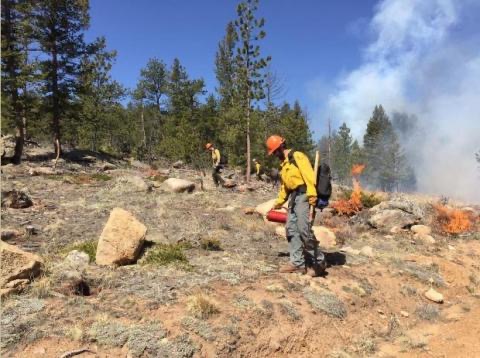Pinecones and New Life

By Jim Nichols
The forestry worker was carrying a red container of fuel. As he poured out the fuel, he simultaneously pulled a trigger that sparked a flame that ignited the fuel. Walking through the forest, he was setting it on fire—on purpose. Why would that be a positive act?
A clearly distinguishing feature of pine trees is, of course, pinecones. These oddly shaped structures are constructed of scales that resemble the slats of Venetian blinds; that is, they can be rotated to be open or closed. Generally closed, the pinecones provide a protective home for tree seeds developing inside. The seeds are shielded from wind and its drying effects plus insects or birds attempting to eat the seeds. During the spring, warmth causes the scales to open and expose the seeds to dispersal.
Jack Pines (among a few others) take this procedure to a new level. Spring warmth is not sufficient to open the cones; it takes a fire.
It is reasonable to consider fire as a forest’s enemy, but that is not always true. A fire can remove ground debris as well as plant competitors of the trees; cleaning up the underbrush can be positive. In addition to the cleanup role, a fire can cause the cones of Jack Pines to open and spread their seeds. In fact, fire is necessary; spring warmth is insufficient. Forest management often uses “controlled/prescribed” burns to maintain a healthy Jack Pine forest. The fire may kill the mature trees, but opens the cones so seeds fall to the ground to start new seedlings. It is as if a resurrection is occurring, a resurrection dependent on fire.

The old mantle clock struck three times. We recently had it lubricated so it is running better, but those three sounds woke me from a deep sleep. I was in a safe place with my wife beside me; it was dark, cool, and quiet. I was awake enough to consider if something important was happening.
Sleep is a mystery of life that we do not easily understand. Why do animals (including humans) have this as part of their natural lives? We become unconscious and unknowing (though perhaps dreaming occasionally), while apparently important activities are occurring in our bodies. I am compelled to trust that I am in a protected place and time. When we wake from sleep, it is as if we have been involved in a mini-resurrection. The difference between sleep and wakefulness is stark, yet in many ways we are the same person.
+++++++
Sleep and wake cycles and the surprise of seeds germinating are so common that we may not connect them to larger patterns that are fundamental to creation. We are consistently seeing something starting and then being replaced or renewed.
Do you understand how a caterpillar in a cocoon can transform into a butterfly? If you do not, you are in good company. Science can describe what is happening, but it does not explain why it is happening or through what mechanisms. Did the caterpillar die or get changed?
Do we understand why water might condense on the grass in the cool of morning and then evaporate after the sun appears? Do we understand how those same water molecules can rise to the sky to form clouds which may then produce rain?
Seasonal changes occur with regularity; one season replaces another on a hidden schedule.
Some of us recently witnessed a total solar eclipse. We saw a loss (should be call that a death?) and then a revival.
Perhaps we should conclude that the creation is based on a series of events that each involve a loss followed by a renewal. This is the pattern no matter what level we choose to consider.
Rather than using the word “death” which implies a definite end, perhaps what we are seeing is death transformed; that language might be more accurate. Paul’s famous one-liner comes to mind: “For me to live is Christ and to die is gain.”
Indeed, this is all quite mysterious. Mark’s gospel uses the illustration of seed scattered on the ground; the sower sleeps and wakes and the seeds sprout and grow, yet “. . . he does not know how.”
Jim Nichols is a retired Abilene Christian University biology professor and current hospital chaplain

You have given me something else to think about. I find it comforting to know that what I may perceive as a very painful event may actually transform into a blessing at a later time. Another example of “I don’t know, nor do I understand, nor do I have to.”
LikeLike